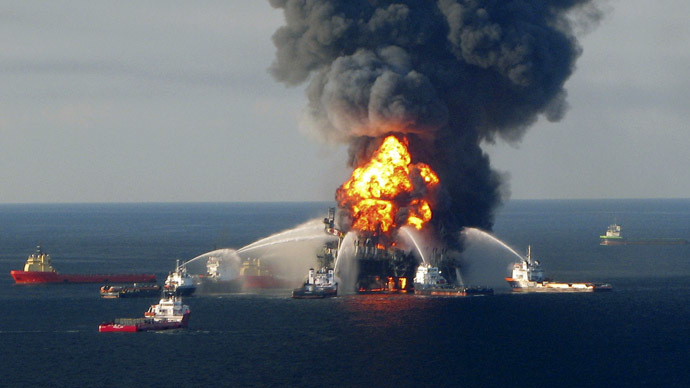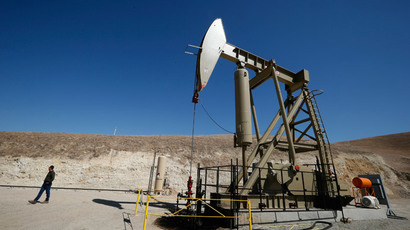Ex-BP manager settles with SEC over Gulf oil spill insider trading charges

Former BP crisis manager Keith A. Seilhan has settled with the SEC after facing insider trading charges related to the massive 2010 Gulf of Mexico oil spill. Seilhan had dumped his company stock before news of the spill’s severity had spread.
According to the federal charges, Seilhan used confidential information on the extent of the 2010 Deepwater Horizon oil spill in the Gulf of Mexico to profit, by selling over $1 million in BP company stock right before the stock crashed. He would have lost about $100,000 if he had sold the stock after the price tumbled, CNNMoney reported.
On April 20, 2010, the BP-operated Deepwater Horizon oil rig exploded, killing 11 workers. Two days later, the rig sank, breaking the seal on the well cap on the ocean floor. As a result, oil gushed from the damaged well for 87 days, ultimately spilling 4.9 million barrels of oil, according to a multi-agency government report released in 2011.
Seilhan had been working for BP for over 20 years when the explosion occurred, according to his LinkedIn profile. Shortly after the spill began, the company deployed him to its Incident Command Center in Houma, La., where he coordinated BP’s initial oil collection and clean-up operations in the Gulf of Mexico and along the coastline. In this role, he received non-public information about the disaster, including oil flow estimates and data relating to the volume of oil floating on the surface of the Gulf.
According to the SEC’s federal court filing, “By April 29, 2010, BP was publicly estimating that the flow rate of the spill was up to 5,000 barrels of oil per day (“bopd”), as set forth in its filings with the Commission. However, the Company’s public estimate was significantly less than the actual flow rate occurring at the time, which was estimated later to be between 52,700 and 62,200 bopd.”
The filing goes on to say: “On April 29 and 30, 2010, while in possession of this material, nonpublic information, and in breach of duties owed to BP and its shareholders, Seilhan caused to be sold his and his family’s entire $1 million portfolio of BP securities...Following Seilhan’s trades, the price of BP ADSs declined by approximately 48% over time, reaching its lowest point in late June 2010.”
The SEC says BP shares closed at $60.48 on the day of the explosion, but fell to $27.02 – the 48 percent decline the SEC referred to above – by late June.
In the facts section of the filing, the SEC goes into more detail of Seilhan’s knowledge of BP’s guidance on insider trading, noting that on May 5, 2010, a BP attorney sent a reminder to employees working on the Deepwater Horizon disaster to avoid potential insider trading. But that e-mail was sent five days after the last of Seilhan’s transactions.
The e-mail pointed out that BP’s code of conduct “prohibits you from trading on the basis of any price sensitive information relating to either BP securities or those of any other publicly traded company," and advised employees to respond with any questions about prohibited transactions. The SEC says that BP’s employees are required to review the Code of Conduct annually.
Seilhan responded to the attorney the same day, saying: “Thanks for this. I would like to discuss with you soon.” The in-house attorney reached out to Seilhan six days later via e-mail and voicemail, but Seilhan never responded back, nor did he disclose his stock sales, the filing said.
Seilhan will pay a $105,409 penalty, $105,409 in restitution, and $13,300 in interest under the terms of the settlement, Fox News reported. The settlement still needs to be approved by a federal judge. Seilhan chose to settle because "Four years have passed and Mr. Seilhan wants to avoid further distraction and protracted litigation," his attorney, Mary McNamara, said in a statement, as reported by AFP.
BP previously paid a $525 million settlement after the SEC claimed that the company publicly underestimated the size of the spill, Businessweek reported. It also pleaded guilty to obstruction of Congress for its underestimation. That guilty plea was part of a $4 billion resolution to 11 felony counts and two misdemeanor charges brought against the company by the US.
BP announced on Tuesday that the “active cleanup” along the Gulf Coast had ended, just in time for the fourth anniversary of the oil rig explosion.
“The U.S. Coast Guard today ended patrols and operations on the final three shoreline miles in Louisiana, bringing to a close the extensive four-year active cleanup of the Gulf Coast following the Deepwater Horizon accident,” a press release stated.
The Coast Guard disputed BP’s conclusion later on Tuesday. “Let me be absolutely clear: This response is not over---not by a long shot,” Capt. Thomas Sparks, the federal on-scene coordinator for the Deepwater Horizon Response, said in a statement. “The transition to the Middle Response process does not end clean-up operations, and we continue to hold the responsible party accountable for Deepwater Horizon cleanup costs.”














